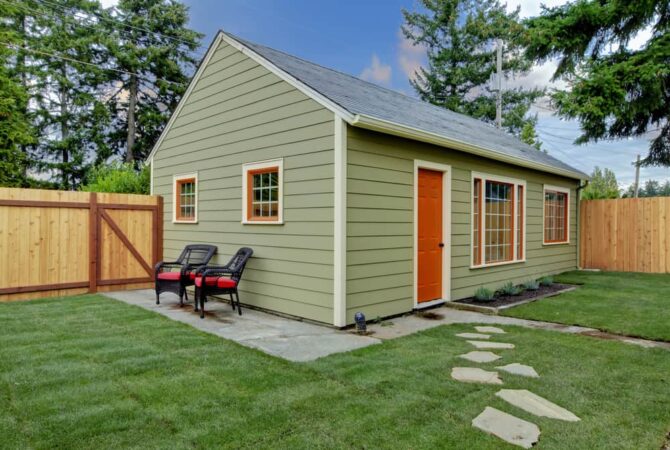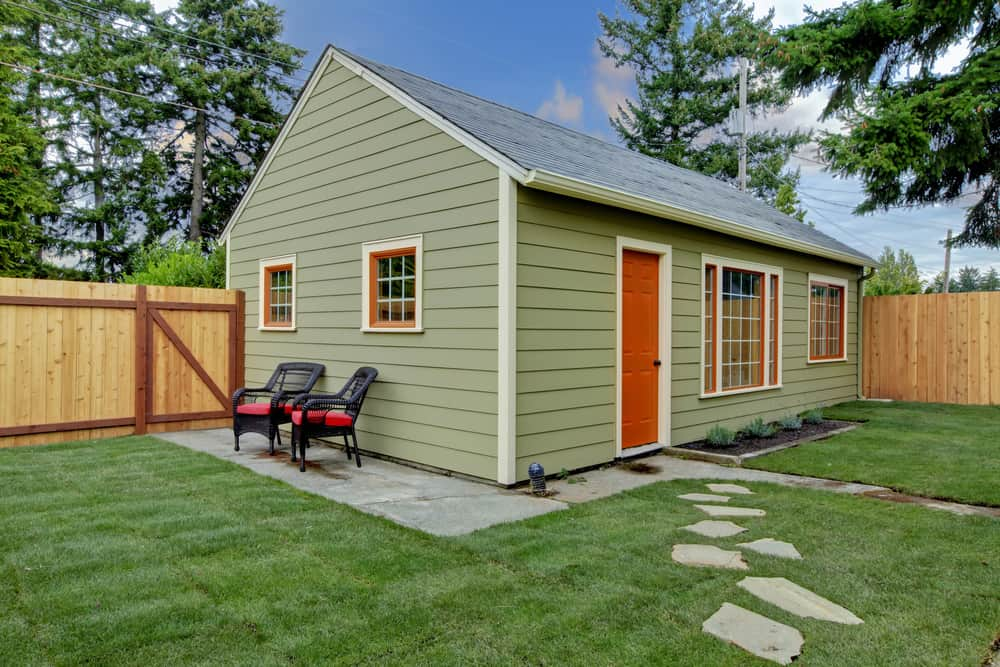Building an ADU? Accessory dwelling units are a great solution for affordable housing. Whether you’re looking to generate passive income, create more space for multigenerational living, or to simply increase property value, here’s what you need to know about ADUs.
- What Is an ADU?
- Types of ADUs
- How Much Does an ADU Cost?
- Pros of Building an ADU
- Cons of Building an ADU
- How to Build an ADU
What Is an ADU?
Commonly known as a backyard cottage, granny flat, or in-law suite, an accessory dwelling unit is a secondary living space located on the same property as the main residence. Though similar to tiny houses in that they’re both small living spaces, the main difference between an ADU vs. a tiny house is that ADUs must be built on the same lot as the primary residence, while tiny homes do not. As an accessory living space, this home addition idea involves implementing residential amenities and features—including a bathroom, kitchen, and sleeping area, along with electrical and plumbing infrastructure. The size range of an ADU depends on where you live, since legal requirements vary by location (e.g., California limits ADUs to an area of 800 square feet and 16 feet tall).
Types of ADUs
Before adding one to your property, you’ll want to consider which type of ADU would work best for you! Where you build an ADU will depend on your property’s available space, area regulations, and your wants and needs.
Attached
An attached ADU is added directly onto the side or top of the existing structure of the main residence. With this more budget-friendly option, you don’t have to start from scratch building the foundation, wiring, and installing amenities. When building an attached ADU, you can opt for a shared entrance with your main residence or create a separate entryway to the ADU for additional privacy. In the case of an upper-level ADU, this would also require building an exterior stairway.
Internal
An internal ADU is located within the main residence and shares the same entrance, but has its own living space, kitchen, and bathroom. Internal ADUs are often built in the attic or basement and are a popular option for multigenerational living, offering privacy for an adult child or aging parent. Internal ADUs also include the subtype of junior ADUs, which are typically smaller and may share a bathroom with the primary residence.
Garage Conversion
A garage conversion ADU turns some or all parts of a garage into a living space. You can also build above the garage, allowing you to continue using the garage itself for parking cars. Homeowners can often get more out of their budget with this type of ADU because the foundation and structure already exist.
Detached
A detached ADU (DADU) is a stand-alone structure commonly built in the backyard. Here, homeowners have the freedom to scale the size up or down depending on available yard space. This type of ADU is especially convenient for use as a rental property or guest house, since it’s completely separate from the main house. A DADU can also be a great option for a loved one who needs a ground-level residence for accessibility reasons. Depending on the requirements in your area, your detached ADU can share utilities with your main residence or you can opt for a separate metering system.
How Much Does an ADU Cost?
Generally, homeowners can expect to spend between $150 to $600 per square foot, but the cost to build an ADU depends on several factors—like where you live, the type of ADU, construction materials, and more. With prefab ADUs, the designs are already approved by local regulations and require no extra architect fees, which saves more time and cost compared to stick-built ADUs. Here are some additional tips on lowering ADU construction costs:
- Research ADU construction experts in your area and choose the one that best fits your needs and budget.
- Reduce ADU size if you don’t need much space.
- Consider renovating existing space rather than building from the ground up.
- Install water and energy-efficient appliances to reduce utility bills—like a dual-flush toilet, smart thermostat, and LED lights.
- Hire professionals for more complex processes (like site assessment, land excavation, building the foundation, and HVAC, plumbing, and electrical systems installation).
- Paint the walls and decorate the interior yourself, using existing furniture from your home.
Pros of Building an ADU
An ADU can be a great investment for many homeowners. From generating passive income to keeping your family close, here are some benefits of building an ADU.
Increase Home Space
If you’re looking to increase square footage in your home, why not add home space with an ADU! Customizing a home office ADU is a good option for artists, creatives, and other people who are working from home. And when you have friends or relatives staying over the weekend, convert your ADU to a temporary guest house.
Create a Multigenerational Living Solution
ADUs are a popular option for keeping family members close while still maintaining a sense of privacy and space. If you have an adult child or aging parent who wants to live near you, an ADU can provide an easier way to balance independence and support.
Provide an Affordable Housing Option
ADUs are a promising solution to housing shortages and growing rental rates in the real estate market. With the growing legalization of ADUs, families or households with one to two people can often rent ADU homes for a more affordable price than a regular house or apartment in the same neighborhood.
Generate Rental Income
Whether you’re looking to pay off your mortgage or build passive income, renting out your ADU for the long term or short term is beneficial. If you’re located in a business or touristy area, you may earn more by turning your ADU into an Airbnb!
Add Property Value
With all the advantages of having an ADU on your property, homes including ADUs are becoming highly sought-after. Building an ADU is a great long-term investment because it increases property value up to 30%, with detached ADUs being the most valuable type.
Cons of Building an ADU
Like any large-scale home improvement project, there are some drawbacks to consider before building an ADU. From climbing material costs to legal regulations, here are some challenges to keep in mind.
Heavy Initial Investment
Though it’s cheaper than buying a new property, building an ADU is an expensive home improvement project. The total cost of an ADU can range anywhere from $60,000 to $360,000. In addition to paying for materials and labor, you’ll have to cover costs for contractor fees, utility installation, and permit fees.
Tenants Can Damage Property
When you have a rental ADU, there’s always a risk of tenants damaging your property due to accidents or negligent behavior. Making repairs costs money and can disrupt your daily schedule.
Legal Considerations
Homeowners who are thinking of building an ADU need to sift through local zoning laws and building regulations, which can be overwhelming. Depending on where you’re located, a pre-inspection may be required to make sure your building plans meet the legal requirements for ADUs in your area. (This involves things like making sure there’s enough usable space to build the ADU, confirming the location of the nearest fire hydrant, and ensuring there’s an accompanying parking space for the ADU.) Additionally, if you’ll be renting out your ADU, you must be compliant with local landlord-tenant laws.
Regular Maintenance Needed
Having an ADU means an additional space you’ll have to maintain on top of your main residence. In addition to keeping the space clean, it’s crucial to make sure all appliances and infrastructure like heating, ventilation, plumbing, and more are in working order.
How to Build an ADU
Ready to build your dream ADU? Whether you’re considering a prefab ADU or looking to fully customize one with professional help, check out our simple guide to get started.
Choose Your ADU Type
Before building your ADU, think about who that space is for and how you want to utilize it. For instance, if the ADU is for an aging parent who has mobility issues, you might want to consider building it on the ground level and making it wheelchair accessible. Factor in lot size and the aesthetics of your main residence as you think about your design choices. If you have a budget and time constraint, a prefab ADU might be a better option compared to a custom one. And most importantly, remember to check local ADU regulations on size limits, land requirements, and the number of units you can build.
Hire a Contractor
Getting the right team to build your ADU is one of the biggest decisions you’ll have to make. It’s important to find a contractor who’s familiar with local ADU zoning laws and policies so they can help you navigate the legal requirements while also designing an ADU that meets your needs. Make sure to ask your contractor questions about licensing and permits, past projects they’ve worked on, and whether they offer a warranty on their services. It’s crucial to find someone you’re comfortable working with as you’ll be spending time together throughout the building process.
Get Approval From the City
Now you’ve hired your contractor, it’s time to get the permits needed to build your ADU. Check with your city for local building plan handouts and inspection checklists. You should work with your contractor on filing and getting your applications approved as they have more experience in this area—some contractors might even file them for you!
Prepare the Site
You’ll need to prep your property before laying down the foundations for your ADU. This can include clearing trees, rocks, fences, or other obstructions, as well as excavating and grading your space. On top of that, your contractor will lay utility lines to provide electrical, plumbing, communications, and gas supply for your ADU.
Build the Exterior
This stage is where the contracted team will lay the foundation for your ADU. If you’re building an ADU from scratch, your contractor would first frame the structure with wooden planks, and then add walls, windows, and roofs to ensure the unit is watertight. Materials like siding, bricks, or stone are commonly used. If you ordered a prefab ADU, your contractor will typically build the outer shell offsite, then transport it to your lot for assembly.
Finish Up the Interior
Once the exterior is sealed, the contractor will now move on to installing utilities and appliances inside your ADU such as lighting, faucets, toilet, kitchen, shower area, and more. A carefully constructed interior should be well-insulated for cold days and well-ventilated to prevent mold and mildew from forming. Last, the contractor will paint the walls and add final touches to your ADU with home decor pieces and furniture. You may also opt to paint and decorate the home by yourself to reduce costs.
***
Need a place to store your belongings or materials while building an ADU? Extra Space Storage has storage facilities located across the country that can help with your transition! Find storage near you.


